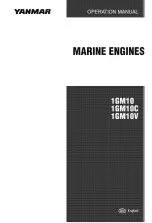
en
Installation and electrical connection
28
WILO SE 2019-01
Work steps
1
6
5
3
4
2
S1
S*
Fig. 12:
Wet well installation, portable
1
Pump support foot
2
Pipe elbow with hose connection or Storz pipe coupling
3
Storz hose coupling
4
Pressure hose
5
Lifting equipment
6
Attachment point
S*
Non-immersed operating mode: Observe information on the rating plate!
‡
Pump support foot mounted.
‡
Pressure connection prepared: Pipe elbow with hose connection or pipe elbow with
Storz coupling mounted.
1. Use a shackle to attach the lifting equipment to the attachment point of the pump.
2. Lift the pump and lower it at the intended location (chamber, pit).
3. Place the pump on a solid bearing surface.
CAUTION! Sinking must be prevented!
4. Lay the pressure hose and fasten it to a certain point (e.g. drainage).
DANGER! Separation or movement of the pressure hose can lead to (serious) in-
juries! Securely attach the pressure hose to the outlet.
5. Lay the power supply cable properly.
CAUTION! Do not damage the power supply
cable!
▶ The pump is installed, the qualified electrician can make the electrical connection.
6.4.6
Stationary dry well installation
NOTICE
Pumping problems due to water level being too low
If the fluid is lowered too much, separation of the volume flow may occur. Further-
more, air cushions may form in the hydraulic system, resulting in undesirable beha-
viour during operation. The minimum permissible water level must reach the upper
edge of the hydraulics housing!
In dry well installation, the operating space is divided into the collecting space and the
machine room. In the collecting space, the fluid flows and is collected; the pump tech-
nology is installed in the machine room. The pump is installed in the machine room and
connected to the pipe system on the suction and pressure side. Observe the following
points for installation:
ƒ
The suction- and pressure-side pipe system must be self-supporting. The pump
must not support the pipe system.
ƒ
Connect the pump to the pipe system ensuring that it is free of stress and vibrations.
The use of elastic connection pieces (compensators) is recommended.
ƒ
The pump is not self-priming, in other words, the fluid must flow in either automati-
cally or with supply pressure. The minimum level in the collecting space must be at
the same height as the upper edge of the hydraulics housing!
ƒ
Max. ambient temperature: 40 °C (104 °F)
Содержание EMU FA
Страница 2: ......
















































